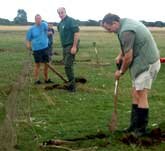
Latest News...
Keep up to date with all the latest events in the Greenshank Migration Story.

Keep up to date with all the latest events in the Greenshank Migration Story.

Date: 09/02/2005
In August 2004 a team of volunteers from Farlington Ringing Group caught and marked over fifty Greenshanks in Chichester Harbour. The catch took place at Thorney Islandby licensed volunteers. Coloured rings were attached to the birds’ legs, arranging the colour combinations so that individual birds can be distinguished. Peter Potts, the group leader, said, ‘It was a great weekend, and we are very pleased. It was one of the largest catches of this species ever made in the UK. Now we are hoping for lots of sightings’.
The catch took place as part of a new project organised by Chichester Harbour Conservancy and Farlington Ringing Group funded by the Heritage Lottery Fund. The project is called ‘Greenshank -The Migration Story’, and will use observations of the birds to track their migration and form links between people in different places. The website is being developed as part of the project to provide information on Greenshanks and their migration, and to encourage people to join in with the project.
Anyone who sees a ringed Greenshank (or any other wader) should send details to Peter Potts at Solent Court Cottage, Chilling Lane, Warsash, SO31 9HF. As well as the date, time and place, observers should record what colours the rings were, on which leg, and where on the leg (above or below the knee). Information on the known history of that bird to date will then be sent back.
Greenshanks are wading birds with long pale green legs and a long slightly upturned bill. They breed in Scotland, Scandinavia and Russia, and visit Chichester Harbour in the autumn on the way to spend the winter further south. During autumn passage around 120 reside in Chichester Harbour, the second most popular area after The Wash for Greenshanks in Britain.
Harbour Conservation Officer Anne de Potier, who is co-ordinating the project, said, ‘Chichester Harbour is hugely important for these and other coastal birds. In this project we want to involve as many people as possible in helping unravel some of the mysteries about these birds and their migration. We need to find out more about the places the birds visit and would like to meet the people who live there. It’s a really exciting project and I am looking forward to twinned schools, Internet links and lasting relationships between communities.’